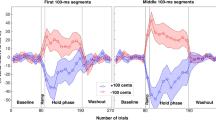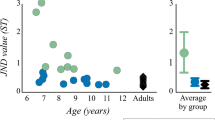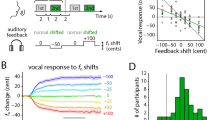Abstract
Humans learn to speak by a process of vocal imitation that requires the availability of auditory feedback. Similarly, young birds rely on auditory feedback when learning to imitate the songs of adult birds, providing one of the few examples of nonhuman vocal learning. However, although humans continue to use auditory feedback to correct vocal errors in adulthood, the mechanisms underlying the stability of adult birdsong are unknown. We found that, similar to human speech, adult birdsong is maintained by error correction. We perturbed the pitch (fundamental frequency) of auditory feedback in adult Bengalese finches using custom-designed headphones. Birds compensated for the imposed auditory error by adjusting the pitch of song. When the perturbation was removed, pitch returned to baseline. Our results indicate that adult birds correct vocal errors by comparing auditory feedback to a sensory target and suggest that lifelong error correction is a general principle of learned vocal behavior.
This is a preview of subscription content, access via your institution
Access options
Subscribe to this journal
Receive 12 print issues and online access
$209.00 per year
only $17.42 per issue
Buy this article
- Purchase on Springer Link
- Instant access to full article PDF
Prices may be subject to local taxes which are calculated during checkout



Similar content being viewed by others
References
Konishi, M. The role of auditory feedback in the control of vocalization in the white-crowned sparrow. Z. Tierpsychol. 22, 770–783 (1965).
Kuhl, P.K. Learning and representation in speech and language. Curr. Opin. Neurobiol. 4, 812–822 (1994).
Arnold, A.P. The effects of castration on song development in zebra finches (Poephila guttata). J. Exp. Zool. 191, 261–278 (1975).
Olveczky, B.P., Andalman, A.S. & Fee, M.S. Vocal experimentation in the juvenile songbird requires a basal ganglia circuit. PLoS Biol. 3, e153 (2005).
Kao, M.H., Doupe, A.J. & Brainard, M.S. Contributions of an avian basal ganglia-forebrain circuit to real-time modulation of song. Nature 433, 638–643 (2005).
Kuhl, P.K. et al. Phonetic learning as a pathway to language: new data and native language magnet theory expanded (NLM-e). Phil. Trans. R. Soc. Lond. B 363, 979–1000 (2008).
Doupe, A.J. & Kuhl, P.K. Birdsong and human speech: common themes and mechanisms. Annu. Rev. Neurosci. 22, 567–631 (1999).
Houde, J.F. & Jordan, M.I. Sensorimotor adaptation in speech production. Science 279, 1213–1216 (1998).
Jones, J.A. & Munhall, K.G. Perceptual calibration of F0 production: evidence from feedback perturbation. J. Acoust. Soc. Am. 108, 1246–1251 (2000).
Leonardo, A. & Konishi, M. Decrystallization of adult birdsong by perturbation of auditory feedback. Nature 399, 466–470 (1999).
Nordeen, K.W. & Nordeen, E.J. Auditory feedback is necessary for the maintenance of stereotyped song in adult zebra finches. Behav. Neural Biol. 57, 58–66 (1992).
Woolley, S.M. & Rubel, E.W. Bengalese finches Lonchura striata domestica depend upon auditory feedback for the maintenance of adult song. J. Neurosci. 17, 6380–6390 (1997).
Tumer, E.C. & Brainard, M.S. Performance variability enables adaptive plasticity of 'crystallized' adult birdsong. Nature 450, 1240–1244 (2007).
Tchernichovski, O., Mitra, P.P., Lints, T. & Nottebohm, F. Dynamics of the vocal imitation process: how a zebra finch learns its song. Science 291, 2564–2569 (2001).
Okanoya, K. & Yamaguchi, A. Adult Bengalese finches (Lonchura striata var. domestica) require real-time auditory feedback to produce normal song syntax. J. Neurobiol. 33, 343–356 (1997).
Brainard, M.S. & Doupe, A.J. Interruption of a basal ganglia-forebrain circuit prevents plasticity of learned vocalizations. Nature 404, 762–766 (2000).
Linkenhoker, B.A. & Knudsen, E.I. Incremental training increases the plasticity of the auditory space map in adult barn owls. Nature 419, 293–296 (2002).
Choe, C.S. & Welch, R.B. Variables affecting the intermanual transfer and decay of prism adaptation. J. Exp. Psychol. 102, 1076–1084 (1974).
Sober, S.J. & Sabes, P.N. Flexible strategies for sensory integration during motor planning. Nat. Neurosci. 8, 490–497 (2005).
Suthers, R.A., Goller, F. & Wild, J.M. Somatosensory feedback modulates the respiratory motor program of crystallized birdsong. Proc. Natl. Acad. Sci. USA 99, 5680–5685 (2002).
Wolpert, D.M., Ghahramani, Z. & Jordan, M.I. An internal model for sensorimotor integration. Science 269, 1880–1882 (1995).
Troyer, T.W. & Doupe, A.J. An associational model of birdsong sensorimotor learning. I. Efference copy and the learning of song syllables. J. Neurophysiol. 84, 1204–1223 (2000).
Nottebohm, F. The road we travelled: discovery, choreography, and significance of brain replaceable neurons. Ann. NY Acad. Sci. 1016, 628–658 (2004).
Wilbrecht, L. & Kirn, J.R. Neuron addition and loss in the song system: regulation and function. Ann. NY Acad. Sci. 1016, 659–683 (2004).
Mooney, R. Synaptic mechanisms for auditory-vocal integration and the correction of vocal errors. Ann. NY Acad. Sci. 1016, 476–494 (2004).
Woolley, S.M. & Rubel, E.W. Vocal memory and learning in adult Bengalese finches with regenerated hair cells. J. Neurosci. 22, 7774–7787 (2002).
Thompson, J.A., Wu, W., Bertram, R. & Johnson, F. Auditory-dependent vocal recovery in adult male zebra finches is facilitated by lesion of a forebrain pathway that includes the basal ganglia. J. Neurosci. 27, 12308–12320 (2007).
Tchernichovski, O., Lints, T., Mitra, P.P. & Nottebohm, F. Vocal imitation in zebra finches is inversely related to model abundance. Proc. Natl. Acad. Sci. USA 96, 12901–12904 (1999).
Adret, P. In search of the song template. Ann. NY Acad. Sci. 1016, 303–324 (2004).
Derégnaucourt, S. et al. Song development: in search of the error-signal. Ann. NY Acad. Sci. 1016, 364–376 (2004).
Clayton, D.F. Songbird genomics: methods, mechanisms, opportunities, and pitfalls. Ann. NY Acad. Sci. 1016, 45–60 (2004).
White, S.A. Learning to communicate. Curr. Opin. Neurobiol. 11, 510–520 (2001).
Acknowledgements
We thank P. Sabes and A. Doupe for critical discussions, T. Warren, K. Bouchard and L. Didier-Sober for technical assistance and J. Wong and R. Mazumder for animal care. This work was supported by the Helen Hay Whitney Foundation (S.J.S.), a McKnight Scholar Award (M.S.B.) and US National Institutes of Health grants R01DC006636 and P50MH77970.
Author information
Authors and Affiliations
Contributions
S.J.S. and M.S.B. designed the experiments and wrote the paper. S.J.S. designed and built the experimental apparatus, conducted the experiments and analyzed the data.
Corresponding author
Supplementary information
Supplementary Text and Figures
Supplementary Figures 1–7 (PDF 371 kb)
Rights and permissions
About this article
Cite this article
Sober, S., Brainard, M. Adult birdsong is actively maintained by error correction. Nat Neurosci 12, 927–931 (2009). https://doi.org/10.1038/nn.2336
Received:
Accepted:
Published:
Issue Date:
DOI: https://doi.org/10.1038/nn.2336
This article is cited by
-
Daily vocal exercise is necessary for peak performance singing in a songbird
Nature Communications (2023)
-
Spontaneous variability predicts compensative motor response in vocal pitch control
Scientific Reports (2022)
-
Driving singing behaviour in songbirds using a multi-modal, multi-agent virtual environment
Scientific Reports (2022)
-
Syringeal vocal folds do not have a voice in zebra finch vocal development
Scientific Reports (2021)
-
A system for controlling vocal communication networks
Scientific Reports (2021)



